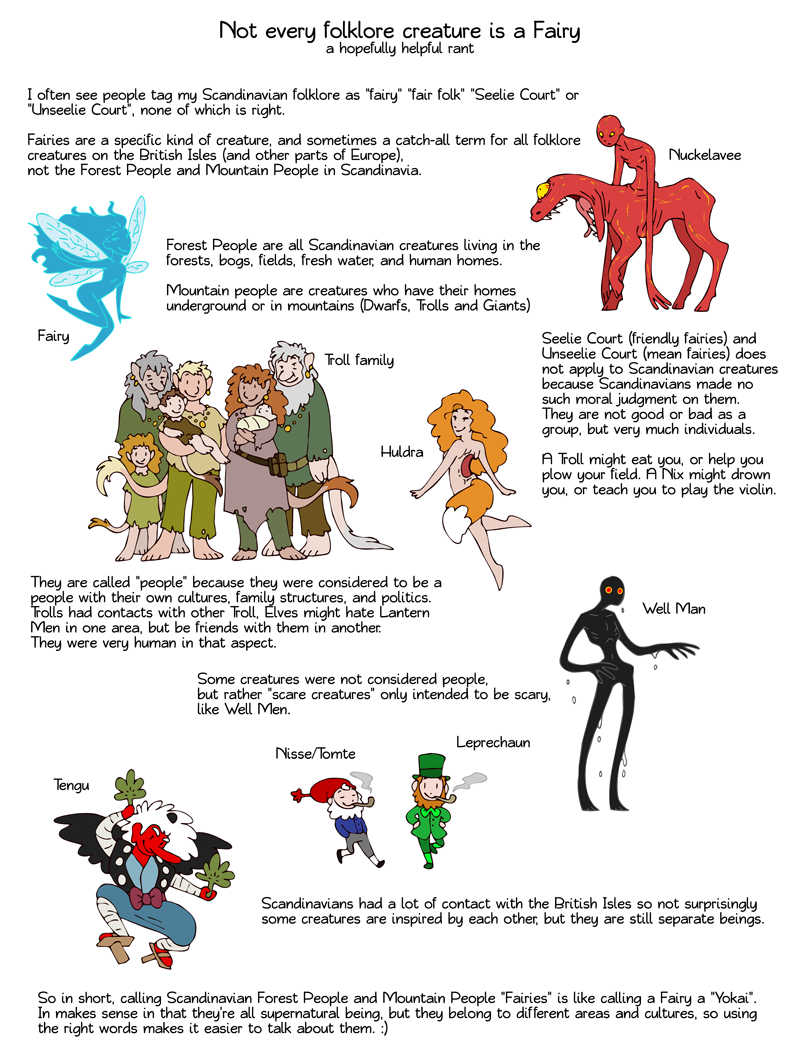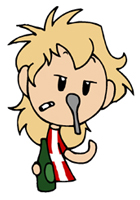Community made Fan Art:
9 years ago #9462699
What is that nuckelavee monster? It must be a scare creature, because it's going to haunt my nightmares.
2
0
What is that nuckelavee monster? It must be a scare creature, because it's going to haunt my nightmares.
9 years ago #9461485
I literally made an account to comment on this one post.....
I just want to point out there is no reason for the last few comments made to essentially bitch and 'correct' that the terms used in this comic weren't specific to some people's liking.
It's a bloody comic and personal opinion, if she wants to define 'seelie and unseelie' in such a way deal with it, every book read claims the fictional/mythical races and such as something different.
I've read books claiming what the comic states and others claiming what the comments state, both are valid but still...
It's mythology not science, it is going to change depending on who read what and grew up where.
Really bugs me Americans are bitching and trying to bring up 'facts' when for all they know it could be a cultural difference or difference in materieals read.
Ffs people it's a webcomic let the poor woman rant as she pleases without trying to start an Internet war of opinions.
2
3
I literally made an account to comment on this one post.....
I just want to point out there is no reason for the last few comments made to essentially bitch and 'correct' that the terms used in this comic weren't specific to some people's liking.
It's a bloody comic and personal opinion, if she wants to define 'seelie and unseelie' in such a way deal with it, every book read claims the fictional/mythical races and such as something different.
I've read books claiming what the comic states and others claiming what the comments state, both are valid but still...
It's mythology not science, it is going to change depending on who read what and grew up where.
Really bugs me Americans are bitching and trying to bring up 'facts' when for all they know it could be a cultural difference or difference in materieals read.
Ffs people it's a webcomic let the poor woman rant as she pleases without trying to start an Internet war of opinions.
9 years ago #9461079
Just a small thing i wish to share apropos the Nuckelavee: https://www.youtube.com/watch?v=1JQpE7n6eUk
2
0
Just a small thing i wish to share apropos the Nuckelavee: https://www.youtube.com/watch?v=1JQpE7n6eUk
9 years ago #9474184
Last verse in a ballad of ours, about the "nykur" (the neck):
13. Nykurin leyp í vatnið kátur,
hálvur maður og hálvur bátur.
The neck leapt in the water merry
half man and half boat
I also remember one of my teachers telling a story, about a neck, living in a nearby lake, who very much enjoyed eating postmen with blackcurrant jame.
1
0
Last verse in a ballad of ours, about the "nykur" (the neck):
13. Nykurin leyp í vatnið kátur,
hálvur maður og hálvur bátur.
The neck leapt in the water merry
half man and half boat
I also remember one of my teachers telling a story, about a neck, living in a nearby lake, who very much enjoyed eating postmen with blackcurrant jame.
9 years ago #9461421
Yes and no. You are of course correct that the Scandinavian folklore is totally different from British folklore. They are different cultures. Although Vikings did colonize parts of Great Britain on several occasions bringing Scandinavian customs. Still, they are not identical.
But British fairies aren't just little naked winged women. The Fair Folk come in many shapes and sizes and were considered people with their own cultures, family structures, and politics. Whether they were considered good or evil depended on the time period, the area, and the influence of Christianity.
Japanese Yokai are not like fairies, they are more like what you call "scare monsters". I would have no problem if a Japanese person were to lump British fairies and Scandinavian Forest and Mountain people in with Japanese Kami, because I think they are all the same class of creatures. Even though they come from different cultures and have different shapes and customs.
I think it comes down to a Lumper/Splitter distinction. You are making the claim that the differences are more important than the similarities. And I am from the camp that thinks the similarities are more important than the differences. This sort of disagreement is not about the facts it is about category boundaries. As such, pointing out differences, or similarities, won't actually change anyone's mind.
1
2
Yes and no. You are of course correct that the Scandinavian folklore is totally different from British folklore. They are different cultures. Although Vikings did colonize parts of Great Britain on several occasions bringing Scandinavian customs. Still, they are not identical.
But British fairies aren't just little naked winged women. The Fair Folk come in many shapes and sizes and were considered people with their own cultures, family structures, and politics. Whether they were considered good or evil depended on the time period, the area, and the influence of Christianity.
Japanese Yokai are not like fairies, they are more like what you call "scare monsters". I would have no problem if a Japanese person were to lump British fairies and Scandinavian Forest and Mountain people in with Japanese Kami, because I think they are all the same class of creatures. Even though they come from different cultures and have different shapes and customs.
I think it comes down to a Lumper/Splitter distinction. You are making the claim that the differences are more important than the similarities. And I am from the camp that thinks the similarities are more important than the differences. This sort of disagreement is not about the facts it is about category boundaries. As such, pointing out differences, or similarities, won't actually change anyone's mind.
9 years ago #9461217
I actually often enough encountered people, who called "Fairies" "Elves"... which annoys me to a similar degree...
When I correct them, most time they directly reply "...where's the difference?", as if it wouldn't be pretty obvious from the get go... ._.
1
0
I actually often enough encountered people, who called "Fairies" "Elves"... which annoys me to a similar degree...
When I correct them, most time they directly reply "...where's the difference?", as if it wouldn't be pretty obvious from the get go... ._.
9 years ago #9461149
I feel it's worth mentioning that it's possible that some of these people are using "fairy" with Tolkien's definition, which is essentially any fantasy creature.
That being said, it's a flimsy way to use it and associates more with fiction writing than actual folklore, so ultimately, I do agree with your rant. Calling trolls fairies seems fundamentally wrong to me.
1
0
I feel it's worth mentioning that it's possible that some of these people are using "fairy" with Tolkien's definition, which is essentially any fantasy creature.
That being said, it's a flimsy way to use it and associates more with fiction writing than actual folklore, so ultimately, I do agree with your rant. Calling trolls fairies seems fundamentally wrong to me.
2 years ago #9877575
I just want to say (as a Japanese-American who grew up on Japanese yokai stories just as much as Western fairy tales), if you were to speak to a Japanese person, they'd call *any* type of creature of myth a yokai. A vampire is a yokai, a werewolf is a yokai, a bugbear is a yokai, a faerie is a yokai, any kind of being that is not a human, an ordinary animal, or a kami (heck, even some kami are also technically yokai! Raijin and Fujin, the brother storm gods, are oni!) are yokai. This is in fact a major plot point in the anime/manga GeGeGe no Kitaro, wherein Kitaro's yokai community come under attack from a group of Western (European) "yokai" led by Backbeard (bugbear), and featuring a few vampires, a pair of witch sisters, a werewolf, and even the Frankenstein monster. Yokai is literally just a term that generalizes "supernatural creature", whether it's one of Japanese origin, or of foreign origin.
Admittedly, it's one thing for someone from Japan to consider all supernatural things as "yokai," (or "bakemono," or "ayakashi," or even "mononoke") because it's the terminology they have for it. I'm more of the mind that there's no excuse for (particularly American fantasy authors) to group all supernatural entities that aren't "demons" or something else they can hang a specific hat on as being "just X country's faeries," which is a thing that happens all too often. Then again, I think that just comes from generalizing; Europe is where fae come from, so clearly, any European mythological critter is a fae, right? Particularly because people hear first and most often about the sorts of things that *are* fae, and then just roll everything under that umbrella from there.
0
0
I just want to say (as a Japanese-American who grew up on Japanese yokai stories just as much as Western fairy tales), if you were to speak to a Japanese person, they'd call *any* type of creature of myth a yokai. A vampire is a yokai, a werewolf is a yokai, a bugbear is a yokai, a faerie is a yokai, any kind of being that is not a human, an ordinary animal, or a kami (heck, even some kami are also technically yokai! Raijin and Fujin, the brother storm gods, are oni!) are yokai. This is in fact a major plot point in the anime/manga GeGeGe no Kitaro, wherein Kitaro's yokai community come under attack from a group of Western (European) "yokai" led by Backbeard (bugbear), and featuring a few vampires, a pair of witch sisters, a werewolf, and even the Frankenstein monster. Yokai is literally just a term that generalizes "supernatural creature", whether it's one of Japanese origin, or of foreign origin.
Admittedly, it's one thing for someone from Japan to consider all supernatural things as "yokai," (or "bakemono," or "ayakashi," or even "mononoke") because it's the terminology they have for it. I'm more of the mind that there's no excuse for (particularly American fantasy authors) to group all supernatural entities that aren't "demons" or something else they can hang a specific hat on as being "just X country's faeries," which is a thing that happens all too often. Then again, I think that just comes from generalizing; Europe is where fae come from, so clearly, any European mythological critter is a fae, right? Particularly because people hear first and most often about the sorts of things that *are* fae, and then just roll everything under that umbrella from there.
Add comment: Please Sign in or create an accout to comment.
View all 26 comments
Copyright © 2009-2024 Humon Comics
Artist's Journal | Artist's Twitter | contact@humoncomics.com | Privacy Policy

















19 F
I mentioned this before on your tumblr account and I feel bad correcting you because you are, for the most part, correct, but Unseelie and Seelie courts were never a distinction between "good" or "evil" fairies, either could be malicious or mean-spirited. Originally the courts, which originated in Ireland, were used to denote whether the fairy liked sunlight or being seen. Unseelie tend to be nocturnal and solitary, Seelie tend to be diurnal and group-oriented. It's more common to see two Seelie together than two Unseelie. Over time the solitary nature of Unseelie was taken as outright reclusiveness, and they gained a reputation for being particularly nasty if you bothered them, particularly on purpose (a banshee will only scream if you get too close to her, a dullahan will blind you if you try to watch him/her on an errand, etc). Unseelie are also commonly associated with death. Dullahan are the Irish personification of death, and banshee warn of an impending death.
Honestly Seelie fairies are a lot closer to a modern definition of evil, as they'll pull pranks unprovoked, even if they can be helpful. Leperchauns, despite being Seelie fairies, are actually probably the one of the nastiest fairies in existence, but they're still Seelie. Really the difference between Seelie and Unseelie fairies isn't whether they're mean or friendly, but whether they often interact with people. Generally you won't see an Unseelie fairy unless you're about to die, and avoiding them will just piss them off and make it more likely that you will die.
Pretty much all fairies dislike humans and/or will kill you if you piss them off so I don't think there's much of a good/evil distinction as there is a reclusive/social distinction.